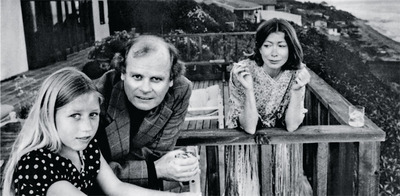Joan Didion is one now, but when she was three her up-and-down marriage to fellow writer John Gregory Dunne was the topic of a 1976 People profile by John Riley. An excerpt:
Every morning Joan retreats to the Royal typewriter in her cluttered study, where she has finally finished her third novel, A Book of Common Prayer, due out early next year. John withdraws to his Olympia and his more fastidious office overlooking the ocean, where he’s most of the way through a novel called True Confessions. “At dinner she sits and talks about her book, and I talk about mine,” John says. “I think I’m her best editor, and I know she’s my best editor.”
While John played bachelor father to Quintana in Malibu, Joan spent a month in Sacramento—where she wrote the last 100 pages of the novel in her childhood bedroom in her parents’ home. She’s retreated there for the final month of all three novels. Her mother delivers breakfast at 9; her dad pours a drink at 6. The rest of the regimen: no one asks any questions about how she’s doing. Joan, a rare fifth-generation Californian, is the daughter of an Air Corps officer. She studied English at Berkeley and at 20 won a writing contest that led to an editing job with Vogue in New York. ‘All I could do during those days was talk long-distance to the boy I already knew I would never marry in the spring,’ she later wrote. John grew up in West Hartford, Conn., where his father was a surgeon. He prepped at a Catholic boarding school, Portsmouth Priory, and studied history at Princeton (where his classmates included Defense Secretary Don Rumsfeld and actor Wayne Rogers). After college he wrote for TIME.
He and Joan met in New York on opposite halves of a double date. When John’s girl passed out drunk in Didion’s apartment, she fixed him red beans and rice and, he recalls, “We talked all night.” Yet they remained only friends for six years until 1963, when they lunched to discuss the manuscript of her first novel, Run River. A year later they married.
California became home after Joan’s hypersensitivity pushed her to the brink of a crack-up in New York. ‘I cried in elevators and in taxis and in Chinese laundries,’ she recalls. “I could not work. I could not even get dinner with any degree of certainty.” Finally, in L.A., John and Joan began alternating columns in The Saturday Evening Post (they are presently sharing a his-and-hers column titled “The Coast” for Esquire). Soon they collaborated on their first filmscript, The Panic in Needle Park (which was co-produced by John’s brother Dominick). Her delicately wrought essays were collected in Slouching Towards Bethlehem, while John turned out nonfiction studies of the California grape workers’ strike (Delano) and 20th Century-Fox (The Studio).
They are only now emerging from two years of antisocial submersion in their novels. “This was the only time we’ve worked simultaneously on books,” John groans. “It was enormously difficult. There was no one to read the mail or serve as a pipeline to the outside world.” Finished ahead of John, Joan is baking bread, gardening and reestablishing contact with cronies like Gore Vidal and Katharine Ross. Unlike most serious writers, Joan and John have banked enough loot from the movies (they did script drafts for Such Good Friends and Play It As It Lays, among others) to indulge in two or three yearly trips to the Kahala Hilton in Hawaii. “Once you can accept the Hollywood mentality that says because you get $100,000 and the director gets $300,000, he’s three times smarter than you are, then it becomes a very amusing place to work,” John observes dryly. But, he adds: “If we didn’t have anything else, I think I’d slit my wrists.”
They’re currently dickering over two Hollywood projects, one about Alaska oil and another about California’s water-rights wars in the 1920s.•
Tags: Gore Vidal, Joan Didion, John Gregory Dunne, John Riley, Katharine Ross, Quintana Dunne

